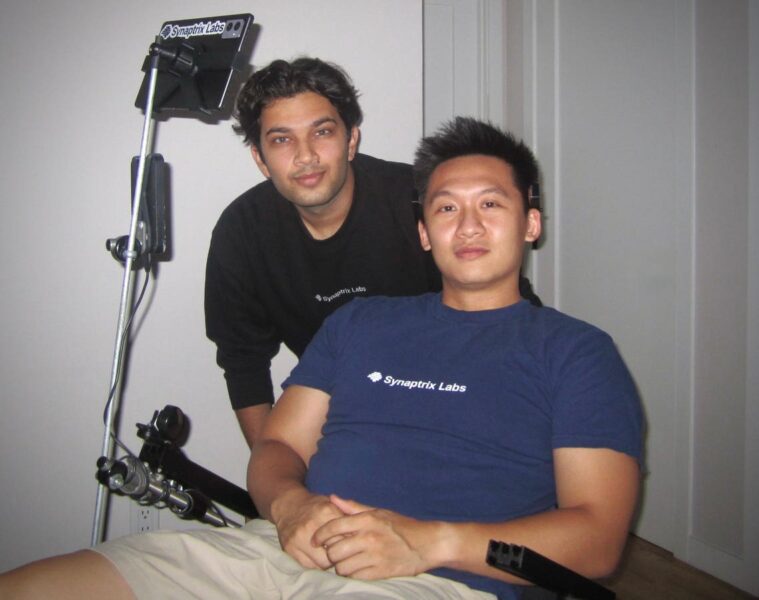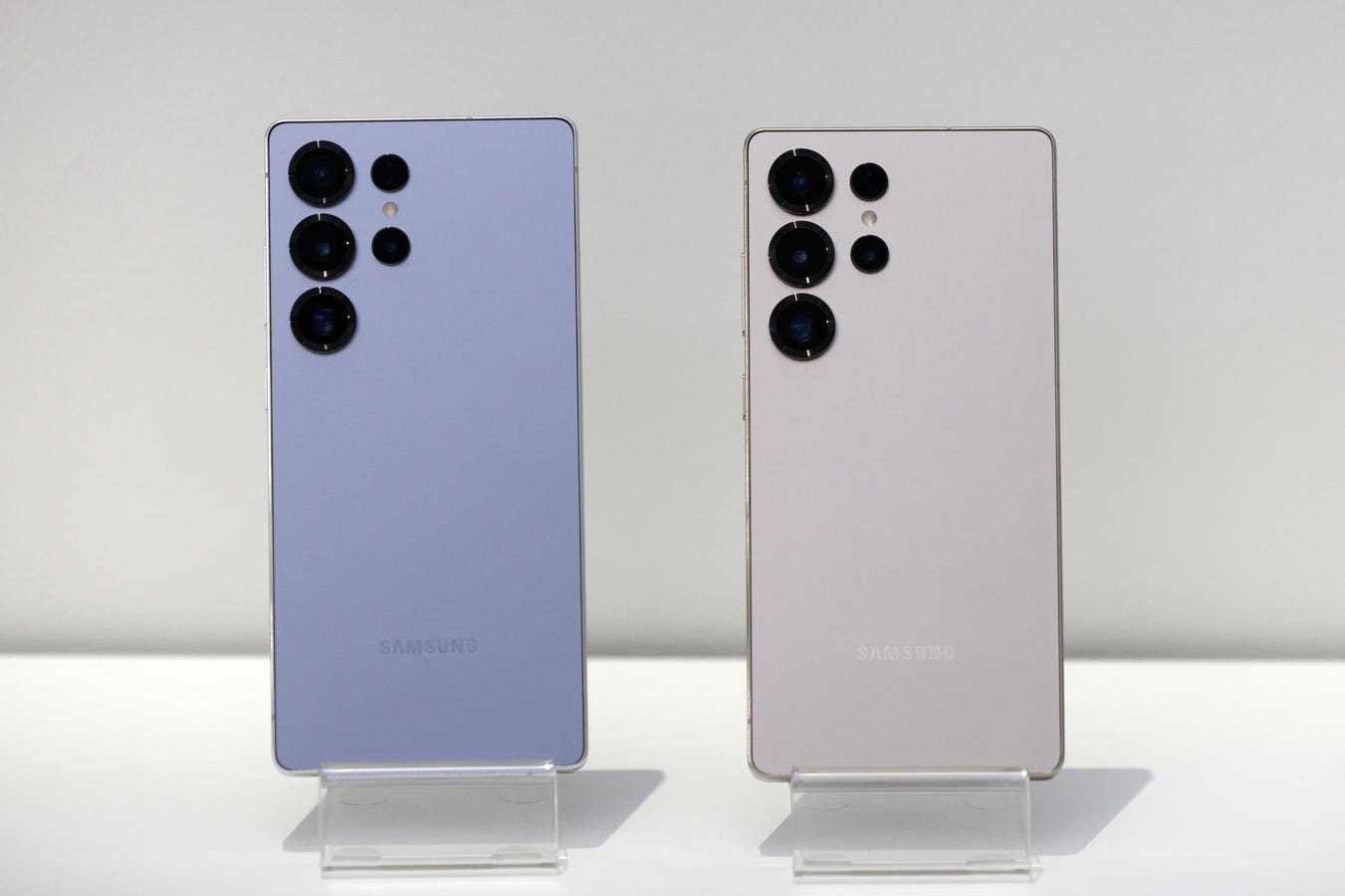Synaptrix Labs, a startup building a wearable brain-computer interface platform recently secured seed funding from Mark Cuban to accelerate commercial traction.
Neuralis is the company’s wearable BCI headset targeting the motor cortex, with dry sensors and on-device signal processing that “decodes subtle EEG signals, effectively translating them into precise wheelchair navigation commands.” The company is prioritizing wheelchair users as their first market through a clinical trial with Columbia University.
Those capabilities are powered by NeuroDiffusion, an AI platform to enable development of both clinical and consumer applications. I recently spoke with CEO and co-founder Aryan Govil to understand his strategy across neurotech markets.
“The future of neurotech lies in deep learning, not chasing better sensors,” he told me. “Mass adoption of interfaces will come from the AI that process the signals, not invasive implants or expensive custom sensors.”
Synaptrix Labs co-founders Aryan Govil and Eric Yao
Synaptrix Labs
Working at a clinical research lab at NYU Langone for five years, Govil saw an unmet need to innovate for people with neurological impairments, but grew skeptical of the cost-benefit and scalability of invasive brain implants by leading BCI startups.
The company was born in 2023, after Govil’s discussions with his then-roommate and now co-founder and CTO Eric Yao, comparing advances in self-driving at Tesla and Waymo. “We saw that a lot of things are happening in the world, and realized that we could come up with a deep learning first approach to solve a lot of the problems with non invasive BCI.”
As a “fundamental math and signal processing guy” Yao’s background in time-series forecasting and quantitative modeling set the duo up to secure pre-seed funding from Underdog Labs and another investor. After winning support from programs at NYU and RESNA, their work caught the eye of Cuban’s team this summer.
“Ultimately they saw that if there is a neurotech revolution in the next five to ten years,” Govil said, “they believe that our deep learning first approach would be the winning path.”
Synaptrix has just secured a licensing agreement with IDUN Technologies that will implement NeuroDiffusion’s artifact removal AI in the EEG headset manufacturer’s hardware for R&D and opens the door for future collaboration. Synaptrix has just moved into a new Manhattan office, where they are adding to seven full-time employees, gearing up for their clinical trial and exploring additional licensing opportunities.
Market Hide and Seek
Synaptrix Labs, “building the next generation of non-invasive brain interfaces,” is the latest healthcare investment by Mark Cuban
Markcubancompanies.com
As a billionaire with neurotech interests. cuban joins Musk, Thiel, Fickel, Hoffman, Ehrsam and Altman, to name a few.
Among this group, Cuban is an outlier in how broadly his interests extend beyond tech and science. His active engagement with the policies and politics of healthcare disruption, as well as business stakes in sports, apparel, food, media, and other consumer verticals go back 15 years and beyond.
As per Govil, Cuban’s overarching vision for advancing accessibility and affordability in US healthcare, typified by his investment in CostPlus Drugs, aligns with Synaptrix Labs’ approach to democratizing neurotech with non-invasive headsets and next-gen AI.
While the check size is undisclosed, two experts not involved in this deal whom I spoke with estimated a ballpark of $8-10 million. What might this mean for other wearable interfaces? Will advances in EEG signal processing impact the outlook for surgically implanted BCI? Some notes on these shifting markets.
- Limited Consumer Interest: It’s not today’s consumer EEG market that drove this deal. Read/write startups like Samphire and Neurode are just setting out to prove market fit. Expectations remain modest for today’s crowded field of ‘read only’ headphone or earbud EEG companies, all angling for research partnerships to supplement product sales. More advanced wearable “remote control” applications, though a staple of student clubs, hobbyists, and hackers around the world have not demonstrated sufficient value to unlock paid consumer markets.
- AI Inflection Point: Advances in ML architectures, deep learning models, and edge computing are diffusing into new markets, bringing powerful denoising capabilities to more entrepreneurs. More reliable and real-time EEG interpretation means more companies building off-the-shelf systems. For enhanced AI capabilities to prove enough of a draw, demonstrated functionality, device ecosystem integration, and application development will be needed.
- Growing Field: Other companies are moving in the same lane as Synaptrix Labs, and this more will follow. One example is Axion Click, an EEG and eye tracking headband startup focused on mouse control for people with impairments. Founder and CEO Raj Reddy describes a similar journey, from “making AR VR interfaces for surgical robots” at Intuitive surgical, meeting his cofounder (“the AI wizard in all of this”) to raising $1 million in pre-seed capital from South Park Commons this year. Axion is targeting the iPad as a first platform.
- Eye Sore: The limits and frustrations of using today’s commonly available eye-tracking tools as a primary communication interface came up numerous times from patients, family members, clinical researchers in neurorehabilitation, and others at the 2025 New York BCI symposium. But even if these startups’ BCI can improve daily life, can such innovations reach this market sustainably?
- Other Assistive Technology: The immediate market for wearable motor BCI is “Assistive Technology” to unlock incremental digital autonomies for motor impaired people and families, at lower price points, immediate timeline, with better safety profiles than implanted devices.
As I wrote last year in a piece about Augmental’s tongue-based interface device, “AT includes tools to help with typing, speech, smart home functionality, as well as wheelchairs, semi autonomous robots, prosthetic or robotic limbs and some stimulation devices. Estimates vary but analysts have pegged this at a $20 billion annual market opportunity that is growing quickly.”
- Cerebral Palsy: At NYBCI, Dr. Leigh Hochberg from Mass General mentioned how one of the fastest growing groups interested in BCI was families with Cerebral Palsy. Mount Sinai’s Dr. Jamie Brannigan posed a critical question when considering these 750,000 potential BCI users: “What is the threshold clinical risk-benefit that will justify implantation in children?”
Noninvasive tools seem a strong fit, as per a recent literature review: “Wearable neurotechnology shows potential to augment upper extremity rehabilitation in children with cerebral palsy, particularly through systems that support task-specific, feedback-driven practice. However, translation to clinical practice is limited by heterogeneity in device design, lack of standardized protocols, and limited high-quality evidence.”
- Extended Reality: Cognixion just announced a clinical trial using Apple’s platform, “testing both a software component (an augmented reality BCI app) and a hardware add-on (a custom headband that can read brain signals) with the Vision Pro.” By combining their own data processing software and 6-sensor EEG device targeting the visual and parietal cortex with Apple’s advanced headsets and best-in-class accessibility platform, Cognixion is aiming to restore real-time, “natural conversational communication” to people and families living with impairments. The company secured FDA Breakthrough designation and CMS authorization as durable medical equipment two years ago, laying unique groundwork for broader market access to their offering.
For Big Tech, an Open Future
Apple’s platform for hardware and software application development appears poised to flood the Assistive Technology field with next-gen tools, from off-the-shelf wearables to XR and even surgically implanted BCI like Synchron’s Stentrode. This represents great news for families waiting for the benefits of advanced technologies in their day to day lives.
Could the other big tech titans of Silicon Valley and beyond launch wearable EEG-based interfaces to do more than track brainwaves, whether for assistive tech or consumer applications? Technically this answer has always been yes, but for years it has not been clear that any of them want to.
On the one hand, AI signal processing has been rapidly improving, to the point where EEG data may soon demonstrably unlock consistent functional restoration or enhancements through device ecosystems and software integration. Meta’s EMG wristband is an early example of what we could see more of in the years ahead.
On the other, the nature of EEG data, such as requirements of device placement, as well as historic and perceived limits in applications, along with possible regulatory challenges, may hinder mass appeal compared to other devices we are used to wearing on our bodies. Samsung, Google, and others are surely tracking advances in EEG closely, but appear to be waiting for a tipping point of utility.
So while mainstream BCI may not be quite here yet, the EEG x AI research partnerships unfolding at Synaptrix Labs and beyond are accelerating possibilities for what wearable devices can do, and how quickly they will be able to reach people who want to use them.









